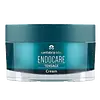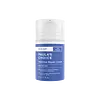What's inside
What's inside
 Key Ingredients
Key Ingredients

 Benefits
Benefits

 Concerns
Concerns

 Ingredients Side-by-side
Ingredients Side-by-side

Water
Skin ConditioningC12-20 Acid PEG-8 Ester
EmulsifyingSnail Secretion Filtrate
Skin ConditioningGlycerin
HumectantHydrolyzed Soy Protein
HumectantPentylene Glycol
Skin ConditioningSaccharide Isomerate
HumectantHexylene Glycol
EmulsifyingLimnanthes Alba Seed Oil
Skin ConditioningCaprylic/Capric Triglyceride
MaskingCetyl Alcohol
EmollientPPG-15 Stearyl Ether
EmollientTocopheryl Acetate
AntioxidantFructose
HumectantGlucose
HumectantPhenoxyethanol
PreservativeUrea
BufferingSodium Lactate
BufferingLactic Acid
BufferingSerine
MaskingSorbitol
HumectantMethylparaben
PreservativeDextrin
AbsorbentSucrose
HumectantSodium Citrate
BufferingSodium Chloride
MaskingDisodium EDTA
Propylparaben
PreservativeAllantoin
Skin ConditioningAlanine
MaskingAspartic Acid
MaskingGlutamic Acid
HumectantHexyl Nicotinate
EmollientParfum
MaskingGeraniol
PerfumingLinalool
PerfumingHexyl Cinnamal
PerfumingLimonene
PerfumingBenzyl Salicylate
PerfumingButylphenyl Methylpropional
PerfumingWater, C12-20 Acid PEG-8 Ester, Snail Secretion Filtrate, Glycerin, Hydrolyzed Soy Protein, Pentylene Glycol, Saccharide Isomerate, Hexylene Glycol, Limnanthes Alba Seed Oil, Caprylic/Capric Triglyceride, Cetyl Alcohol, PPG-15 Stearyl Ether, Tocopheryl Acetate, Fructose, Glucose, Phenoxyethanol, Urea, Sodium Lactate, Lactic Acid, Serine, Sorbitol, Methylparaben, Dextrin, Sucrose, Sodium Citrate, Sodium Chloride, Disodium EDTA, Propylparaben, Allantoin, Alanine, Aspartic Acid, Glutamic Acid, Hexyl Nicotinate, Parfum, Geraniol, Linalool, Hexyl Cinnamal, Limonene, Benzyl Salicylate, Butylphenyl Methylpropional
Water
Skin ConditioningEthylhexyl Stearate
EmollientSimmondsia Chinensis Seed Oil
EmollientButylene Glycol
HumectantGlycerin
HumectantCaprylic/Capric Triglyceride
MaskingPetrolatum
EmollientCetearyl Alcohol
EmollientDimethicone
EmollientDipentaerythrityl Hexacaprylate/Hexacaprate
EmulsifyingGlyceryl Stearate
EmollientTridecyl Trimellitate
EmollientPEG-100 Stearate
Phenyl Trimethicone
Skin ConditioningRetinol
Skin ConditioningAdenosine
Skin ConditioningPalmitoyl Tetrapeptide-7
Skin ConditioningPalmitoyl Hexapeptide-12
Skin ConditioningPalmitoyl Tripeptide-1
Skin ConditioningCeramide Ng
Skin ConditioningSodium Hyaluronate
HumectantMagnesium Ascorbyl Phosphate
AntioxidantNiacinamide
SmoothingTocopherol
AntioxidantLecithin
EmollientLinoleic Acid
CleansingLinolenic Acid
CleansingRetinyl Palmitate
Skin ConditioningGlycyrrhiza Glabra Root Extract
BleachingCamellia Oleifera Leaf Extract
AstringentCitrullus Lanatus Fruit Extract
Skin ConditioningLens Esculenta Fruit Extract
Skin ConditioningPyrus Malus Fruit Extract
Skin ConditioningGlycine Soja Sterols
EmollientTribehenin
EmollientPEG-10 Phytosterol
EmulsifyingMagnesium Aluminum Silicate
AbsorbentSodium PCA
HumectantSodium Lactate
BufferingPullulan
Xanthan Gum
EmulsifyingSodium Hydroxide
BufferingNeopentyl Glycol Dicaprylate/Dicaprate
EmollientCetearyl Glucoside
EmulsifyingTridecyl Stearate
EmollientBehenyl Alcohol
EmollientSclerotium Gum
Emulsion StabilisingCarbomer
Emulsion StabilisingC12-15 Alkyl Benzoate
AntimicrobialPolysorbate 20
EmulsifyingDisodium EDTA
Sorbic Acid
PreservativePhenoxyethanol
PreservativeChlorphenesin
AntimicrobialBenzoic Acid
MaskingWater, Ethylhexyl Stearate, Simmondsia Chinensis Seed Oil, Butylene Glycol, Glycerin, Caprylic/Capric Triglyceride, Petrolatum, Cetearyl Alcohol, Dimethicone, Dipentaerythrityl Hexacaprylate/Hexacaprate, Glyceryl Stearate, Tridecyl Trimellitate, PEG-100 Stearate, Phenyl Trimethicone, Retinol, Adenosine, Palmitoyl Tetrapeptide-7, Palmitoyl Hexapeptide-12, Palmitoyl Tripeptide-1, Ceramide Ng, Sodium Hyaluronate, Magnesium Ascorbyl Phosphate, Niacinamide, Tocopherol, Lecithin, Linoleic Acid, Linolenic Acid, Retinyl Palmitate, Glycyrrhiza Glabra Root Extract, Camellia Oleifera Leaf Extract, Citrullus Lanatus Fruit Extract, Lens Esculenta Fruit Extract, Pyrus Malus Fruit Extract, Glycine Soja Sterols, Tribehenin, PEG-10 Phytosterol, Magnesium Aluminum Silicate, Sodium PCA, Sodium Lactate, Pullulan, Xanthan Gum, Sodium Hydroxide, Neopentyl Glycol Dicaprylate/Dicaprate, Cetearyl Glucoside, Tridecyl Stearate, Behenyl Alcohol, Sclerotium Gum, Carbomer, C12-15 Alkyl Benzoate, Polysorbate 20, Disodium EDTA, Sorbic Acid, Phenoxyethanol, Chlorphenesin, Benzoic Acid
Ingredients Explained
These ingredients are found in both products.
Ingredients higher up in an ingredient list are typically present in a larger amount.
This ingredient is an emollient, solvent, and texture enhancer. It is considered a skin-softener by helping the skin prevent moisture loss.
It helps thicken a product's formula and makes it easier to spread by dissolving clumping compounds.
Caprylic Triglyceride is made by combining glycerin with coconut oil, forming a clear liquid.
While there is an assumption Caprylic Triglyceride can clog pores due to it being derived from coconut oil, there is no research supporting this.
Learn more about Caprylic/Capric TriglycerideDisodium EDTA plays a role in making products more stable by aiding other preservatives.
It is a chelating agent, meaning it neutralizes metal ions that may be found in a product.
Disodium EDTA is a salt of edetic acid and is found to be safe in cosmetic ingredients.
Learn more about Disodium EDTAGlycerin is already naturally found in your skin. It helps moisturize and protect your skin.
A study from 2016 found glycerin to be more effective as a humectant than AHAs and hyaluronic acid.
As a humectant, it helps the skin stay hydrated by pulling moisture to your skin. The low molecular weight of glycerin allows it to pull moisture into the deeper layers of your skin.
Hydrated skin improves your skin barrier; Your skin barrier helps protect against irritants and bacteria.
Glycerin has also been found to have antimicrobial and antiviral properties. Due to these properties, glycerin is often used in wound and burn treatments.
In cosmetics, glycerin is usually derived from plants such as soybean or palm. However, it can also be sourced from animals, such as tallow or animal fat.
This ingredient is organic, colorless, odorless, and non-toxic.
Glycerin is the name for this ingredient in American English. British English uses Glycerol/Glycerine.
Learn more about GlycerinPhenoxyethanol is a preservative that has germicide, antimicrobial, and aromatic properties. Studies show that phenoxyethanol can prevent microbial growth. By itself, it has a scent that is similar to that of a rose.
It's often used in formulations along with Caprylyl Glycol to preserve the shelf life of products.
Sodium Lactate is the sodium salt of lactic acid, an AHA. It is a humectant and sometimes used to adjust the pH of a product.
This ingredient is part of our skin's NMF, or natural moisturizing factor. Our NMF is essential for the hydration of our top skin layers and plasticity of skin. NMF also influences our skin's natural acid mantle and pH, which protects our skin from harmful bacteria.
High percentages of Sodium Lactate can have an exfoliating effect.
Fun fact: Sodium Lactate is produced from fermented sugar.
Learn more about Sodium LactateWater. It's the most common cosmetic ingredient of all. You'll usually see it at the top of ingredient lists, meaning that it makes up the largest part of the product.
So why is it so popular? Water most often acts as a solvent - this means that it helps dissolve other ingredients into the formulation.
You'll also recognize water as that liquid we all need to stay alive. If you see this, drink a glass of water. Stay hydrated!
Learn more about Water